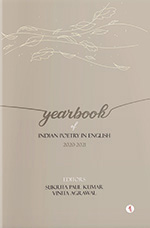The task of a poetry editor is both exciting and onerous. The most difficult genre to ‘judge’ for quality, poetry’s intimate and earnest vocabulary defies any fixed norms. While each poet is supremely individual, so is each reader, and therefore literary responses can be highly subjective. Nevertheless, if the incremental interest in this genre is to be systematized for public circulation, editors have to make choices within the amplitude confronting them. Sukrita Paul Kumar and Vinita Agrawal, editors of the Yearbook of Indian Poetry in English, 2020-2021 have fulfilled their task admirably though it is a specially difficult year when the pandemic has thrown up poetry as a favoured instrument of self-healing.
At a first glance into the contents, one is amazed by the diversity of voices presented even though the language is English. The postcolonial ‘writing back to the Empire’ has now changed to confidently displaying sparkling innovations in the English language which is freely related to regional expressions. For example, ‘ghutan’ is an emotive term for pandemic-induced ‘suffocation’. This hardly needs further explanation and the vernacular is used most successfully: ‘This season, I am told,/ even the mango trees are heavy with ghutan’ (K Srilata). Another word, ‘Pagri’/turban, has numerous connotations of tradition, legacy and honour that are dramatically explored by Kashiana Singh as a metaphor for poetry, showing the English syntax stretching like the crisp cotton fabric of her father’s headgear. As Sukrita and Vinita emphasize in the Introduction, ‘The journey commenced in search of our own English which has negotiated with the rich repertoire of literary traditions and languages in this country.’

